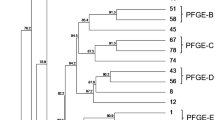Abstract
Seven different phenotyping methods for strain differentiation ofCandida albicans (auxono-typing, enzymotyping, resistotyping, Phongpaichit's morphotyping, Hunter's morphotyping and Odds and Abbott's biotyping method — 1980 and 1983 versions) were compared on a single population of 94 strains. 77.6% of the strains belonged to auxono-typing 1, 59.6% to enzymotyping A, 34% to resistotyping B and 30.8% to BC, 40.4% to Phongpaichit's morphotyping 000,000 and 40.4% to Hunter's morphotyping ‘No fringe/Smooth surface’. Using biotyping systems (1980 and 1983 versions), the most frequent biotypes were 145 (29.8%) and 147 (31.9%) respectively. The Discriminatory Index of Hunter and Gaston was employed to carry out comparisons among the different systems. The best discriminatory results, although far from ideal, were found using Phongpaichit's morphotyping (DI=0.827) and Odds and Abbott's method (DI=0.815 and 0.831 — 1980 and 1983 versions). A good discriminatory result was also found using Hunter's morphotyping method together with the biotyping of Odds and Abbott (1983 version). These approximated the ideal (DI=0.950) and showed minimal difficulty in interpretation. The proposed combined method revealed high discrimination among the vulvovaginal strains, and suggested the absence of transmissible pathogenic strains.
Similar content being viewed by others
References
Anaissie E. Opportunistic mycoses in the immunocompromised host: experience at a cancer center and review. Clin Infect Dis 1992; 14 (Suppl 1): S43–53.
Casal Roman M, Linares Sicilia MJ. Preliminary investigation ofCandida albicans biovars. J Clin Microbiol 1983; 18: 430–431.
Childress CM, Holder IA, Neely AN. Modifications of aCandida albicans biotyping system. J Clin Microbiol 1989; 27: 1392–1394.
Cooper BH, Silva-Hutner M. Yeasts of medical importance. In: Manual of clinical microbiology, 4th ed. Washington, DC: American Society for Microbiology, 1985.
Edwards JE.Candida species. In: Principles of practice of infectious diseases, 3rd ed. New York: Churchill Livingstone, 1990.
Hunter PR, Fraser CAM. Application of a numerical index of discriminatory power to a comparison of four physiochemical typing methods forCandida albicans. J Clin Microbiol 1989; 27: 2156–2160.
Hunter PR, Fraser CAM, Mackenzie DWR. Morphotype markers of virulence in human candidal infections. J Med Microbiol 1989; 28: 85–91.
Hunter PR, Gaston MA. Numerical index of the discriminatory ability of typing systems: an application of Simpson's index of diversity. J Clin Microbiol 1988; 26: 2465–2466.
Merz WG.Candida albicans strain delineation. Clin Microbiol Rev 1990; 3: 321–324.
Odds FC.Candida and candidosis: A review and bibliography, 2nd ed. London: Bailliere Tindall, 1988.
Odds FC, Abbott AB. A simple system for the presumptive identification ofCandida albicans and differentiation of strains within the species. Sabouradia 1980; 18: 301–317.
Odds FC, Abbott AB. Modification and extension of test for differentiation ofCandida species and strains. Sabouradia 1983; 21: 79–81.
Phongpaichit S, Mackenzie DWR, Fraser C. Strain differentiation ofCandida albicans by morphotyping. Epidemiol Infection 1987; 99: 421–428.
Roberts GD, Goodman NL, Land GA, Larsh HW, McGinnis MR. Detection and recovery of fungi in clinical specimens. In: Manual of clinical microbiology, 4th ed. Washington, DC: American Society for Microbiology, 1985.
Warnock, DW. Typing ofCandida albicans. J Hosp Infect 1984; 5: 244–252.
Warnock DW, Speller DCE, Day JK, Farrell AJ. Resistogram method for differentiation of strains ofCandida albicans. J Appl Bacteriol 1979; 46: 571–578.
Williamson MI, Samaranayake LP, MacFarlane TW. Biotypes ofCandida albicans using the API 20C system. FEMS Microbiol Lett 1986; 37: 27–29.
Author information
Authors and Affiliations
Rights and permissions
About this article
Cite this article
Otero, L., Vázquez, F., Palacio, V. et al. Comparison of seven phenotyping methods forCandida albicans . Eur J Epidemiol 11, 221–224 (1995). https://doi.org/10.1007/BF01719492
Accepted:
Issue Date:
DOI: https://doi.org/10.1007/BF01719492



